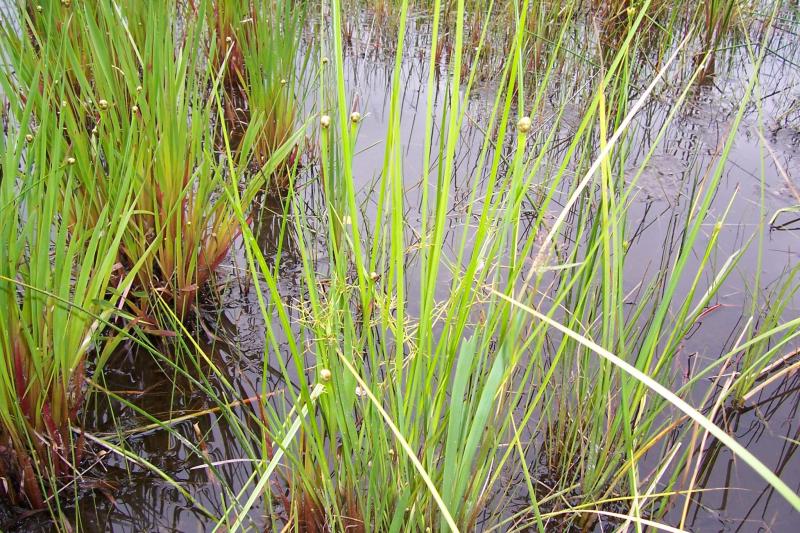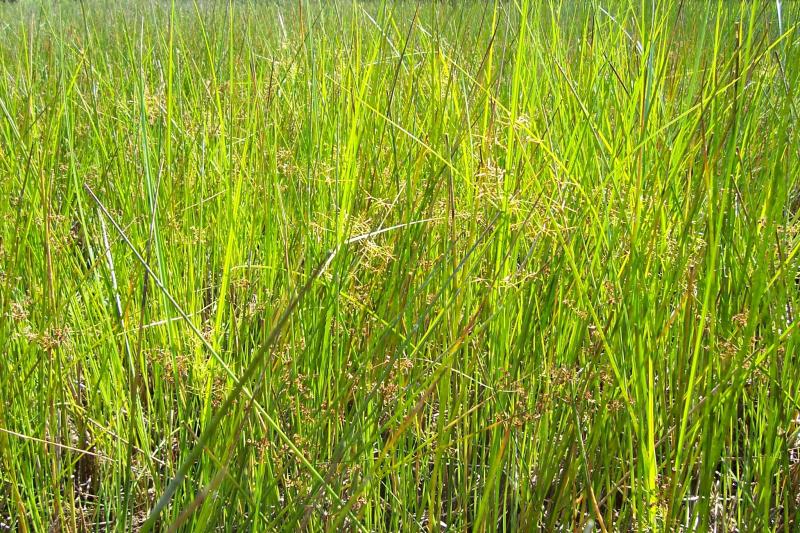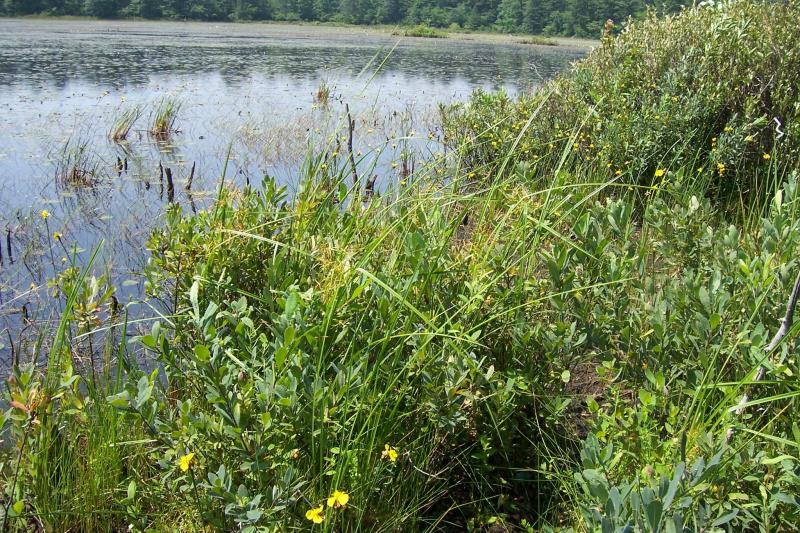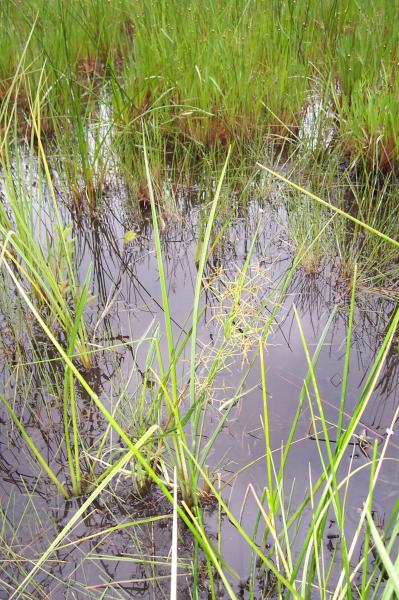Horned Beak Sedge
Rhynchospora inundata (Oakes) Fern.
- Class
- Monocotyledoneae (Monocots)
- Family
- Cyperaceae (Sedge Family)
- State Protection
- Threatened
Listed as Threatened by New York State: likely to become Endangered in the foreseeable future. For animals, taking, importation, transportation, or possession is prohibited, except under license or permit. For plants, removal or damage without the consent of the landowner is prohibited.
- Federal Protection
- Not Listed
- State Conservation Status Rank
- S1
Critically Imperiled in New York - Especially vulnerable to disappearing from New York due to extreme rarity or other factors; typically 5 or fewer populations or locations in New York, very few individuals, very restricted range, very few remaining acres (or miles of stream), and/or very steep declines.
- Global Conservation Status Rank
- G4
Apparently Secure globally - Uncommon in the world but not rare; usually widespread, but may be rare in some parts of its range; possibly some cause for long-term concern due to declines or other factors.
Summary
Did you know?
There is little doubt about this plant's watery habitat preference with a species name like inundata.
State Ranking Justification
There are three existing populations and two of them consist of more than one hydrologically connected pond. The third population is less than 100 plants. All populations are within parkland. There are five historical populations from the early and mid-1900s which have been resurveyed but no plants have been found. They are not considered extirpated because of the fluctuating nature of the populations.
Short-term Trends
Most populations have been surveyed twice, about 20 years apart, and their short-term trend appears to be stable.
Long-term Trends
The long-term trend may be somewhat negative. There appear to be fewer populations now than in the past but the fluctuating nature of these populations make it difficult to assess the long-term trend. More survey work is needed at historical populations to understand the direction of the trend.
Conservation and Management
Threats
Some ponds are threatened with direct disturbance by trampling and ATV use although this threat is diminished in recent years. The invasion of Phragmites is also a threat to a few populations.
Conservation Strategies and Management Practices
The pondshores need to be protected from direct disturbance by ATVs and excessive trampling. Exotic invasive species must be prevented from colonizing the pondshores and any existing populations must be eliminated. A natural buffer of at least 200 feet should be established around the ponds to prevent excessive runoff and pollution events.
Habitat
Habitat
This beakrush grows on the upper exposed margin of coastal plain ponds in mucky soils. One population grows in an abandoned cranberry bog that is now a sedge meadow with about two feet of water. The plants grow in shallow mucky substrate over sand (New York Natural Heritage Program 2012). Swamps and pond margins (Gleason and Cronquist 1991). Inundated pond margins and wet peat (Fernald 1950).
Associated Ecological Communities
- Coastal plain pond shore
(guide)
The gently sloping shore of a coastal plain pond with seasonally and annually fluctuating water levels. Plants growing on the pond shore vary with water levels. In dry years when water levels are low there is often a dense growth of annual sedges, grasses, and herbs. Submerged and floating-leaved aquatic plants, such as fragrant waterlily and pondweeds, may become "stranded" on the exposed shore. In wet years when the water level is high only a few emergents and floating-leaved aquatics may be noticeable. T
Associated Species
- Eleocharis robbinsii (Robbins's spike-rush)
- Gratiola aurea (golden hedge-hyssop)
- Juncus militaris (bayonet rush)
- Pontederia cordata (pickerelweed)
- Rhynchospora macrostachya (tall horned beak sedge)
- Sagittaria engelmanniana (Engelmann's arrowhead)
- Utricularia striata (striped bladderwort)
- Xyris smalliana (Small's yellow-eyed-grass, large yellow-eyed-grass)
Range
New York State Distribution
This wetland sedge is only known from Suffolk County, Long Island.
Global Distribution
This plant is most common in Florida with scattered populations west to Alabama, Mississippi, Louisiana, and East Texas. It also extends north along the coast where it is rare in every state from Georgia to Long Island and Southern New England. It is absent from Virginia.
Identification Comments
General Description
Drowned beakrush is an erect annual or short-lived perennial marsh plant that produces long, coarse, rhizomes and grows 1-2 meters tall. The stems are triangular and the main leaves are mostly 4-7 mm wide. The terminal inflorescence is diffusely branched with brown to tan spikelets that stick out in all directions. Most of the scales of the spikelets are empty and not keeled. The spikelets can be solitary or in clusters of 2-6. The 6 bristles below the achenes are about of equal length of 8-12 mm and conspicuously longer than the achene. The achene is 3.5-4.5 mm long with a long pointed at the top from 14-19 mm long (FNA 2002).
Identifying Characteristics
Distinguishing characteristics: Loosely stoloniferous; culms rather slender, 2-6 dm. high; leaves 3-7 mm. broad; inflorescences 1-2.5 dm. long, diffuse, the glomerules with 1-6 spikelets; achenes 4.2-4.8 mm. broad; tubercle 1.5-1.7 cm. long; longest bristles 0.9-1.1 cm. long. Best life stage for ID: in fruit. Characteristics needed to ID: roots and culms with mature achenes.
Best Life Stage for Proper Identification
The plants are best identified when they are in flower or mature fruit with stems and roots present.
Similar Species
Rhynchospora macrostachya, tall beakrush, looks very similar but its spikelets are more packed together in clusters of mostly 10-30 spikelets. The plants are also without rhizomes (FNA 2002).
Best Time to See
Flowers August to early September, fruits persist through September.
- Fruiting
The time of year you would expect to find Horned Beak Sedge fruiting in New York.
Horned Beak Sedge Images
Taxonomy
Horned Beak Sedge
Rhynchospora inundata (Oakes) Fern.
- Kingdom Plantae
- Phylum Anthophyta
- Class Monocotyledoneae
(Monocots)
- Order Cyperales
- Family Cyperaceae (Sedge Family)
- Order Cyperales
- Class Monocotyledoneae
(Monocots)
- Phylum Anthophyta
Additional Common Names
- Horned Rush
Synonyms
- Ceratoschoenus inundatus (Oakes) House
Additional Resources
Best Identification Reference
Flora of North America Editorial Committee. 2002. Flora of North America, North of Mexico. Volume 23. Magnoliophyta: Commelinidae (in part): Cyperaceae. Oxford University Press, New York. 608 pp.
Other References
Fernald, M.L. 1950. Gray's manual of botany. 8th edition. D. Van Nostrand, New York. 1632 pp.
Gleason, Henry A. and A. Cronquist. 1991. Manual of Vascular Plants of Northeastern United States and Adjacent Canada. The New York Botanical Garden, Bronx, New York. 910 pp.
Holmgren, Noel. 1998. The Illustrated Companion to Gleason and Cronquist's Manual. Illustrations of the Vascular Plants of Northeastern United States and Adjacent Canada. The New York Botanical Garden, Bronx, New York.
Mitchell, Richard S. and Gordon C. Tucker. 1997. Revised Checklist of New York State Plants. Contributions to a Flora of New York State. Checklist IV. Bulletin No. 490. New York State Museum. Albany, NY. 400 pp.
New York Natural Heritage Program. 2010. Biotics database. New York Natural Heritage Program. New York State Department of Environmental Conservation. Albany, NY.
New York Natural Heritage Program. 2024. New York Natural Heritage Program Databases. Albany, NY.
Weldy, T. and D. Werier. 2010. New York flora atlas. [S.M. Landry, K.N. Campbell, and L.D. Mabe (original application development), Florida Center for Community Design and Research http://www.fccdr.usf.edu/. University of South Florida http://www.usf.edu/]. New York Flora Association http://newyork.plantatlas.usf.edu/, Albany, New York
Links
About This Guide
This guide was authored by: Stephen M. Young
Information for this guide was last updated on: September 6, 2012
Please cite this page as:
New York Natural Heritage Program. 2024.
Online Conservation Guide for
Rhynchospora inundata.
Available from: https://guides.nynhp.org/horned-beak-sedge/.
Accessed July 26, 2024.



